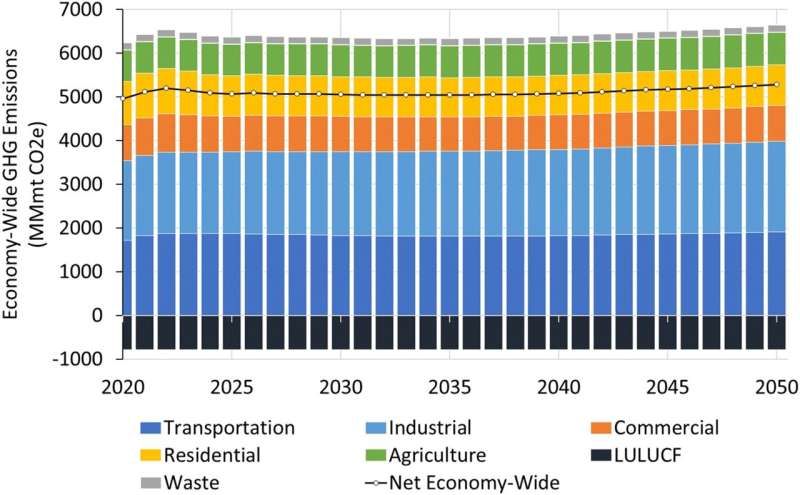
While the world would love to have a quick fix, there is no one specific pathway to stop or slow the rate of climate change.
Scientists are developing multiple strategies to reduce carbon emissions in, and remove them from, the atmosphere—processes known collectively as decarbonization. In fact, the holy grail of climate change research is finding viable decarbonization pathways to achieve the U.S. government's target of net-zero greenhouse gas (GHG) emissions by 2050.
While decarbonization pathways are complex, varied and specific to individual industries, clean-energy technologies and low- and zero-carbon fuels are integral to all carbon dioxide (CO2) mitigation strategies across the U.S. economy. And as scientists develop strategies, they are also creating tools to assess them.
Now, scientists at the U.S. Department of Energy's (DOE) Argonne National Laboratory have introduced the Decarbonization Scenario Analysis Model, which measures the effect of carbon mitigation approaches on energy use and GHG emissions across the U.S. economy. The tool benefits from Argonne's Greenhouse gases, Regulated Emissions, and Energy use in Technologies (GREET) lifecycle analysis models.
In a recently published paper in the journal Sustainable Energy & Fuels, researchers applied the Decarbonization Scenario Analysis Model to analyze decarbonization scenarios from 2020 through 2050 across five sectors of the U.S. economy: transportation, industrial, agriculture, residential/commercial and energy power.
The emissions of CO2 and other GHGs, such as methane, that are warming the planet come primarily from these sectors of the economy.
The study was led by Saurajyoti Kar, an Argonne post-doctoral appointee and a developer of the model. He and his colleagues say policy and technology analysts can use the open-source tool to assess carbon-mitigation approaches specific to each industry.
"The model estimates the total energy use across the economy and focuses on how we will meet that energy demand into the future," said Troy Hawkins, manager of the Fuels and Products Group in Argonne's Energy Systems and Infrastructure Analysis division and a developer of the model. "With this tool, we are helping various industries understand what the future might look like to help guide their decarbonization planning."
"Economy-wide decarbonization at a sustainable rate is a complex topic. It requires a dynamic systemic and life-cycle approach to assess feasibility," said Kar. "The approach must take into account the transitioning energy demands across the economy, as well anthropogenic (originating from human activity) greenhouse gas emissions."
Using a comprehensive approach combining top-down and bottom-up modeling, the total based on life-cycle analysis of technology pathways provides a high level of detail, Hawkins said. Top-down modeling offers a high-level perspective, while bottom-up modeling analyzes individual scenarios in detail.
Developing carbon-mitigation strategies
After analyzing decarbonization scenarios from 2020 to 2050, researchers developed carbon mitigation strategies for each sector. Researchers proposed one ambitious decarbonization pathway that reduced GHG emissions by 80-90% economy-wide in 2050 compared to the baseline. The modeling effort represents various factors, trends, and potential advancements expected to occur in the U.S. energy landscape over the specified timeframe.
Key components of the economy-wide pathway are the replacement and scale-up of the electric grid with renewable energy sources such as wind, solar, hydropower, geothermal, and biomass; partially electrifying the transportation sector; using low- or zero-carbon biofuels; improving building energy efficiency and replacing natural gas with renewable energy sources.
While the economy-wide carbon-mitigation pathway itself is feasible, reducing GHG emissions 80-90% would be enormously challenging. Progress depends on transforming each area of the economy, including deep CO2 emission cuts across all industries and in hard-to-abate sectors like aerospace and locomotives.
Importantly, the model is not intended to put users on an overnight path to net-zero. Rather, the Decarbonization Scenario Analysis Model is a data-backed tool to help users assess what is and what is not working in specific decarbonization scenarios to guide future decisions. For example, making choices on technology—the engine that drives decarbonization—can impact carbon mitigation for years or even decades down the line.
"Our goal was to assess rapid and widespread scale-up of technologies capable of dramatically reducing greenhouse gas emissions. We are working to understand interactions and synergies between those technologies in specific scenarios," said Hawkins. "This tool helps users understand the potential of the technologies they invest in, along with key knowledge gaps and risks."
Researchers focused on transitioning from high-carbon to low-carbon technologies, making current technologies more efficient and replacing conventional fuel with renewable options.
Since technology advances at different rates based on industry, scenarios in the model have been designed individually for each sector of the economy. For example, "In the carbon reduction scenarios for each industry, users can change the parameters and see the changes in effective carbon reduction," Kar said.
The model does not include carbon-negative technology such as carbon capture and storage but can be expanded to include carbon-reduction technologies that would reduce CO2 emissions even further. Expansion of biofuel pathways could also reduce CO2 emissions.
"Our group will continue to develop these models and take this analysis further to address some gaps we identified and consider additional scenarios and technology," Hawkins said.
More information: Saurajyoti Kar et al, A deep decarbonization framework for the United States economy – a sector, sub-sector, and end-use based approach, Sustainable Energy & Fuels (2024). DOI: 10.1039/D3SE00807J
Citation: Decarbonization scenario model analyzes ambitious pathways to net-zero carbon emissions (2024, April 16) retrieved 16 April 2024 from https://techxplore.com/news/2024-04-decarbonization-scenario-ambitious-pathways-net.html
This document is subject to copyright. Apart from any fair dealing for the purpose of private study or research, no part may be reproduced without the written permission. The content is provided for information purposes only.
